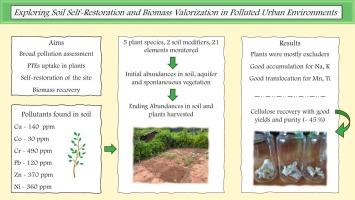评估受污染城市绿色环境中的pte,并提出可持续的恢复方法
IF 4.1
2区 环境科学与生态学
Q1 ECOLOGY
引用次数: 0
摘要
本研究调查了常见植物从被污染的城市土壤中吸收污染物的潜力,该土壤由于毒性问题已经被遗弃了三年,目的是使其成为城市绿色空间的多功能再利用。我们首先对自然生长的植被进行了分类调查,从中选择了最适合进一步研究的物种。采用半定量ICP-OES法评估植物浓缩潜在有毒元素(pte)和必需营养素的能力,并在初步筛选的基础上,选择5种植物进行对照田间试验。在试验之前,对灌溉水(取自当地含水层)和土壤中的污染物浓度进行了评估。此外,使用BCR方案评估了六种超过法规限制的关键污染物(Co, Cr, Cu, Ni, Pb, Zn)的流动性,发现污染物是非流动性的(< 7%),只有Zn例外。在旱季进行为期5个月的田间试验,在不同的土壤条件下种植所选树种。施用了两种土壤改良剂:一种降低ph的剂(FeSO₄)提高pte的流动性和吸收,一种有机堆肥促进生物质生产,从而提高总元素回收率。还包括未经处理的对照图进行比较。土壤改良剂对植物吸收模式和生物量生产均有影响。虽然所有物种都积累了营养物质和低至中等水平的pte(所有污染物的生物积累和转运因子均低于1),但它们产生了大量生物量,特别是在经过堆肥处理的区段。在生长季节结束时,收获的生物质被成功地加工以回收其纤维素部分,实现最佳产量(~ 45%),同时最大限度地减少残留废物。本文章由计算机程序翻译,如有差异,请以英文原文为准。

Assessing PTEs in a polluted urban green environment and proposing sustainable approaches for its recovery
This study investigates the potential of common plant species to uptake contaminants from a polluted urban soil, which has remained abandoned for three years due to toxicity concerns, with the goal of enabling its multifunctional reuse as an urban green space. We firstly conducted a taxonomic survey of the spontaneously growing vegetation, from which we selected the most suitable species for further study. Plant ability to concentrate potentially toxic elements (PTEs) and essential nutrients was assessed by a semi-quantitative ICP-OES assay and, based on this preliminary screening, five plant species were chosen for a controlled in field experiment. Before the trial, pollutant concentrations were evaluated in the irrigation water (drawn from the local aquifer) and the soil. Furthermore, the mobility of six key pollutants exceeding regulatory limits (Co, Cr, Cu, Ni, Pb, Zn) was assessed with the BCR protocol and pollutants were found to be non-mobile (< 7 %), with Zn only exception.
The five-month in field experiment was conducted during the dry season and involved planting the selected species under different soil conditions. Two soil amendments were applied: a pH-lowering agent (FeSO₄) to enhance PTEs mobility and uptake, and an organic compost to promote biomass production thus increasing the total element recovery. Untreated control plots were also included for comparison.
Soil improvers affected both plant uptake patterns and biomass production. While all species accumulated nutrients and low to moderate levels of PTEs (bioaccumulation and translocation factors were below 1 for all pollutants), they developed substantial biomass, especially in compost-amended sections. At the end of the growing season, the harvested biomass was successfully processed to recover its cellulosic fraction, achieving optimal yields (∼45 %) while minimizing residual waste.
求助全文
通过发布文献求助,成功后即可免费获取论文全文。
去求助
来源期刊

Ecological Engineering
环境科学-工程:环境
CiteScore
8.00
自引率
5.30%
发文量
293
审稿时长
57 days
期刊介绍:
Ecological engineering has been defined as the design of ecosystems for the mutual benefit of humans and nature. The journal is meant for ecologists who, because of their research interests or occupation, are involved in designing, monitoring, or restoring ecosystems, and can serve as a bridge between ecologists and engineers.
Specific topics covered in the journal include: habitat reconstruction; ecotechnology; synthetic ecology; bioengineering; restoration ecology; ecology conservation; ecosystem rehabilitation; stream and river restoration; reclamation ecology; non-renewable resource conservation. Descriptions of specific applications of ecological engineering are acceptable only when situated within context of adding novelty to current research and emphasizing ecosystem restoration. We do not accept purely descriptive reports on ecosystem structures (such as vegetation surveys), purely physical assessment of materials that can be used for ecological restoration, small-model studies carried out in the laboratory or greenhouse with artificial (waste)water or crop studies, or case studies on conventional wastewater treatment and eutrophication that do not offer an ecosystem restoration approach within the paper.
 求助内容:
求助内容: 应助结果提醒方式:
应助结果提醒方式:


